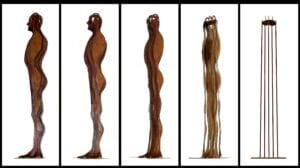
Parallax Sculpture
It seems like the most natural obvious thing to us. We open our eyes and there’s the world, we feel the warmth of the sun, we hear sounds, and we smell the coffee brewing. But if you stop and think about it, perception is anything but simple.
The external world consists of light, noise, objects, odors, buildings, trees, people. We register everything through our senses which use some mysterious organic information processing in our brains to sort it all out and make sense of it. Reality is what our brains tell us it is.
Given that we see the world through two small meat orbs called eyes, it’s incredible that what we perceive is a seamless, three-dimensional environment we call reality. It’s actually a virtual world, put together by the perception of what’s around us. That’s how things seem to us, but is that actually how the world around us really is?
We call what our billions of neurons tell us is going on, consciousness. In effect, consciousness is an immersive reality manufactured by our senses and experiences that we know as a high definition, fully interactive 3D movie, playing to an audience of one.
Which leads me to the question, does everyone else see a color the same way I do? Is my blue the same as yours? When I create a sculpture, are you seeing the same thing as me? It’s really hard to know what other people are seeing. I recall someone looking at a six foot wide crab sculpture I made and saying, “what a beautiful butterfly”.
With the conundrum of perception in mind, I have created several sculptures using parallax design which challenge the idea of perception. You see one image at one point, and something else at another. This dual image design challenges the common notion that what you see is what you get.

Looking at a parallax sculpture from the side, the viewer sees multiple layers of two-dimensional steel plates that come together in the mind to produce a recognizable three-dimensional image – a human head, or a figure. As the viewer changes position, one sees only the vertical edges of the plates standing parallel to one another. We no longer see the form we previously recognized. Our brains have to try and make sense of this shape shifting illusion.
Creating the parallax illusion
The first step in creating this phenomenon entails designing parallel sections that define the intended imagery. This involves slicing three-dimensional objects into discrete vertical layers.
The recognizable subject (a portrait head for example) utilizes strategically placed planes, whereas the realization of the parallax involves a shift in position and perception. The angles which make this possible have a variable effect between understanding the forms and the de-evolution of their visual behavior – very much like the amorphous dot pattern that forms a picture in the newspaper. A dense area of interaction between the plates can become opaque through a flattening out in our perception of depth. Controlling the reduction of scale in relation to the angle of the viewer is an important element in the change and transformation potential of the sculpture. The image formed by the plates interacting with one another at various distances becomes dynamic through the action of movement and angle of perception.
Interaction of plane
The principle of shape interaction becomes the second major element in creating the parallax. The interaction of light and shadow sets the stage for change and transformation in the sculpture. This dialogue between light and shadow is a complex interplay between light intensity, density, and negative space.
If one angle is the single point of view, only possible through photography, the dynamic imagery within the parallax remains hidden. As the angle of incidence increases, the parallax effect gives way to intellectual delight – selective positioning and visual persistence interact to increase the potential for Gestalt transformation of the sculpture.




